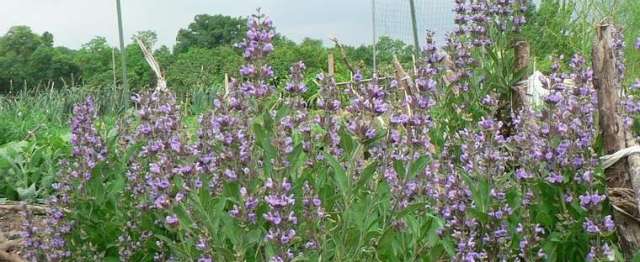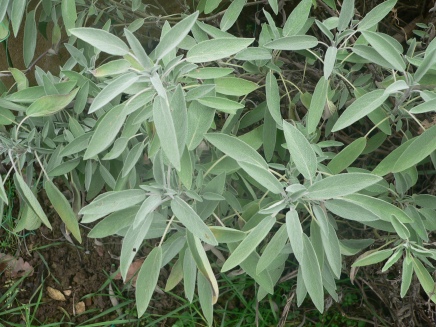
General Information
Salvia officinalis, known as common sage, has a range native to the Mediterranean and Northern Africa. It is a member of the mint family, lamiaceae. This plant is an herbaceous perennial. Sage prefers to grow in full sun in dry to medium, well-drained soil. Sage is highly drought resistant. Butterflies are attracted to this plant for pollination. Sage grows from 2 to 2.5 feet tall and is most identifiable by its fragrant leaves. The flowers bloom in June. Each flower is two-lipped and is lavender-blue in color. The leaves are wrinkled, grey-green, and can reach up to 4 inches long.

Sage flower

Sage leaves
Medicinal Uses
Common sage was used as traditional medicine in many cultures. Ancient Egyptians used the tea of sage leaves as a fertility drug and ancient Greeks used sage liqueur reduce bleeding in ulcers and sores. Herbalists believed ingesting sage leaves could remedy rheumatism, excessive menstrual bleeding, and reduce lactation after child nursing ended. Gargling tea made from sage leaves was performed to relax a sore throat and suppress coughing. Currently, individuals are using sage to treat indigestion, inflammation, and sweat reduction, specifically in menopausal hot flashes.
Chemical Constituents
The most notable chemical components in common sage is camphor. This waxy substance is a terpenoid. Camphor is known to be effective against pathogens such as yeasts, molds, and bacteria. Although, in high quantities camphor can be toxic. Another toxic chemical that makes up a large portion of the chemical constituents is thujone. Thujone is a ketone and monoterpene, and was once thought of to be the hallucinogenic component of absinthe. Sage also contains rosmarinic acid and carnosic acid, which both have antioxidant properties.
Current Research
The research that has been done on common sage supports some of the traditional uses for the plant. As noted by the ancient herbalists, sage is proven to be a great anti-inflammatory. A study published this year broke down the chemical constants of sage, and studied the mode of action. They found that many of these chemical constituents were anti-inflammatory and could have some implications for individuals fighting inflammatory diseases. An interesting avenue of modern research of common sage is in memory. Plants in the genus Salvia are known to have positive impacts on memory. One study showed that the essential oil of common sage inhibited an Alzheimer causing enzyme by 46%. Another study proved that sage could be used as a treatment for mild to moderate Alzheimer disease. Additionally, the study did not show any adverse side effects to the patients.
Sources
Bonesi, M., Loizzo, M. R., Acquaviva, R., Malfa, G. A., Aiello, F., & Tundis, R. (2017). Anti-inflammatory and antioxidant agents from Salvia genus (Lamiaceae): an assessment of the current state of knowledge. Anti-inflammatory & anti-allergy agents in medicinal chemistry.
Hamidpour M, Hamidpour R, Hamidpour S, Shahlari M. Chemistry, Pharmacology, and Medicinal Property of Sage (Salvia) to Prevent and Cure Illnesses such as Obesity, Diabetes, Depression, Dementia, Lupus, Autism, Heart Disease, and Cancer. Journal of Traditional and Complementary Medicine. 2014;4(2):82-88. doi:10.4103/2225-4110.130373.
http://www.herbwisdom.com/herb-sage.html
http://www.missouribotanicalgarden.org/PlantFinder/PlantFinderDetails.aspx?kempercode=m260
